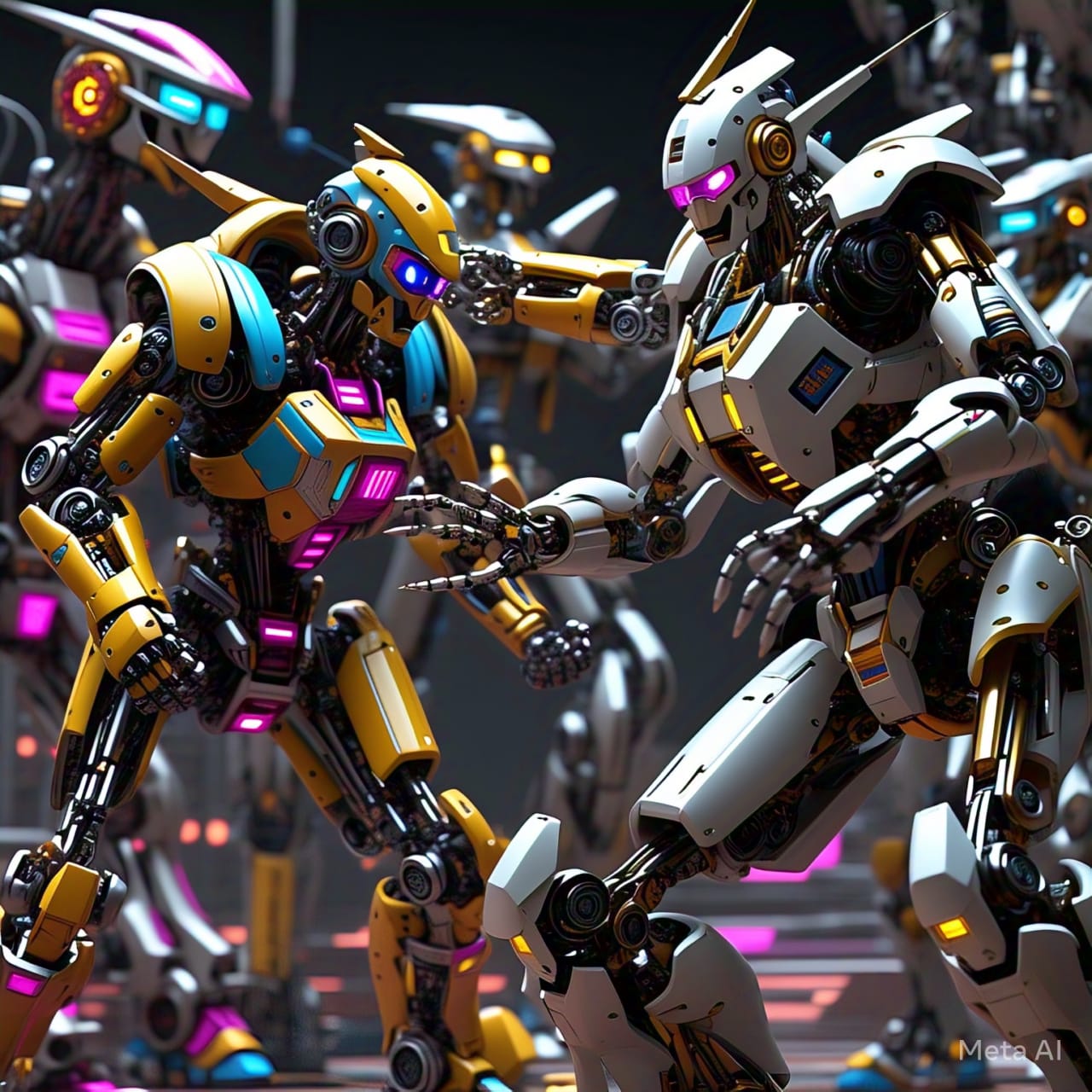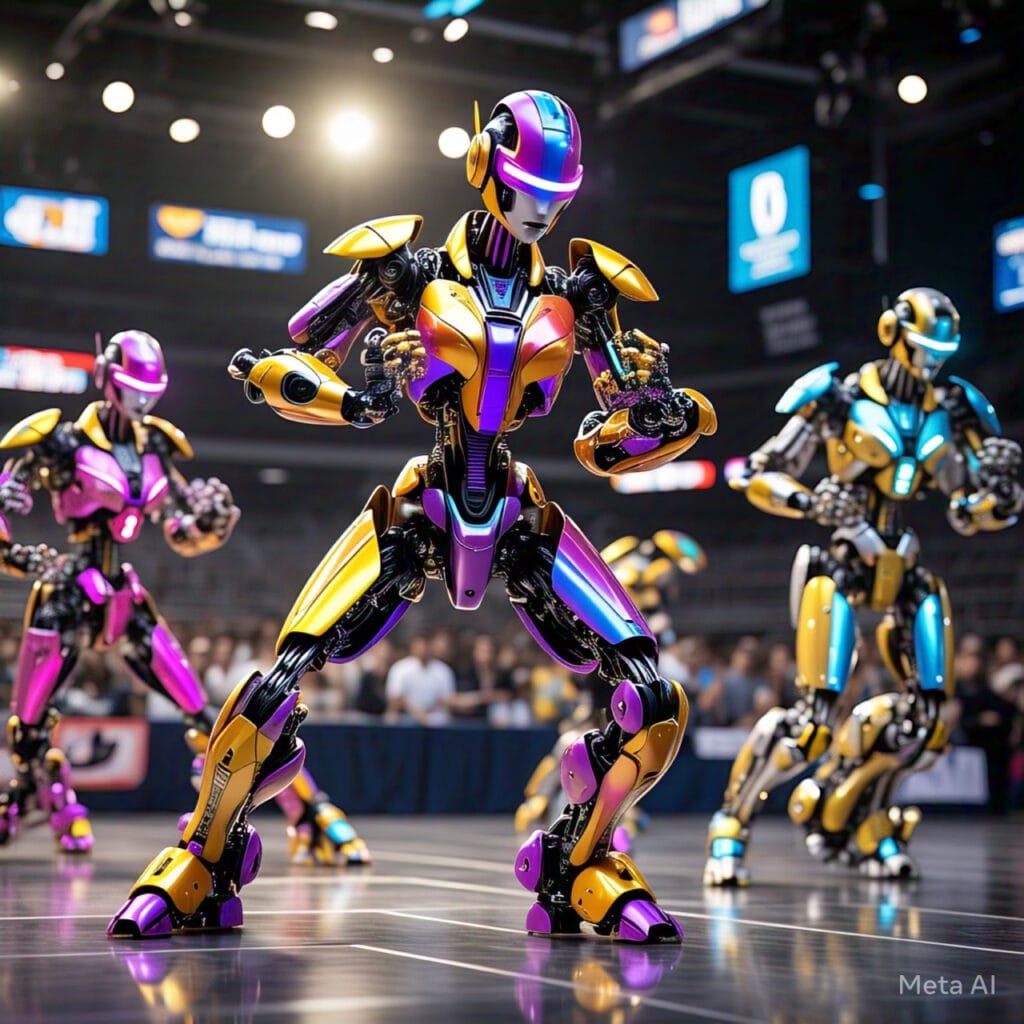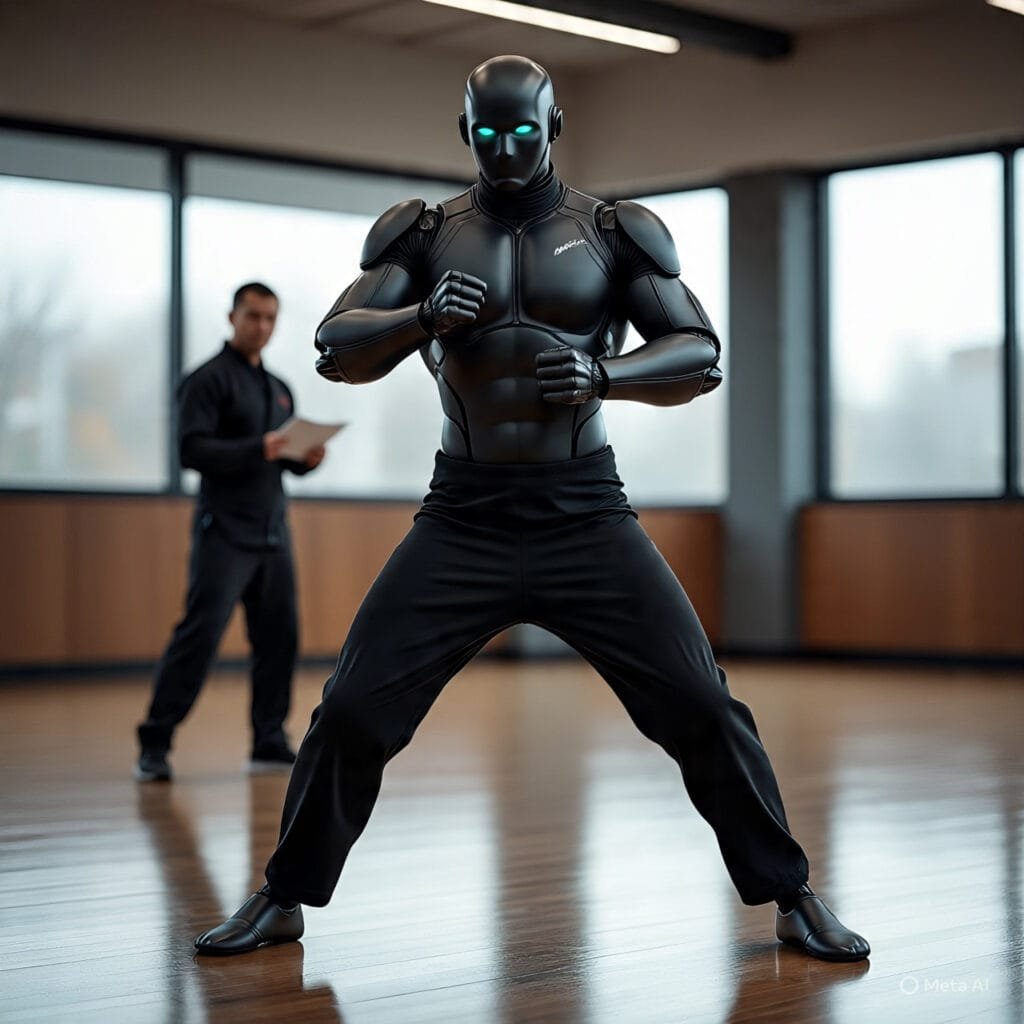The landscape of martial arts training is rapidly evolving, influenced by advancements in technology. robotic training partners…
As we witness the integration of innovative tools and techniques into various aspects of our daily lives,
the question arises: can robots truly revolutionize martial arts training?
The intersection of technology and traditional practices opens a myriad of possibilities that suggest a significant shift in how martial arts can be taught and learned.
In recent years, technological advancements have already begun to reshape the training methodologies in martial arts.
From virtual reality simulations to advanced fitness trackers, practitioners now have access to an arsenal of tools designed to enhance their abilities.
The emergence of robotic technology brings a new dimension to this evolution,
allowing for more interactive and adaptive learning experiences.
Imagine training with a robot that can analyze your movements in real-time, providing immediate feedback on
- technique,
- timing,
- and form.
This capability could lead to more efficient learning processes as students receive personalized guidance tailored specifically to their
strengths and weaknesses.
Moreover, the incorporation of robots in martial arts training could enhance safety and accessibility.
Traditionally, sparring with a partner may pose risks of injury, particularly for beginners.
Robots could serve as controlled training partners, reducing the likelihood of harm while allowing practitioners to hone their skills.
Additionally, this technology could make martial arts training more accessible to individuals with disabilities,
offering tailored programs that cater to various physical capabilities.
As we explore the potential of robots in martial arts training,
it is essential to consider not only the benefits but also the implications for the art form itself.
Will the essence of martial arts be preserved in this new technological paradigm?
This blog aims to delve into these questions, evaluating how integrating robots might transform the future of martial arts education.

Videos are added as random thoughts 💭 💭.
Innovative Training Robots: Pioneering the Future
The integration of robots into martial arts training is rapidly evolving,
leading to the development of innovative robotic systems designed to enhance the educational experience for martial artists.
Among these, the RoboCoach stands out as a notable example.
The RoboCoach is equipped with advanced artificial intelligence that allows it to analyze a student’s technique in real-time,
providing instantaneous feedback to help improve accuracy and form.
This robot can simulate a range of human movements, mimicking various opponents,
which makes it ideal for practicing different fighting styles.
Its capability to adjust difficulty levels based on a student’s skill set ensures a personalized training regimen,
allowing practitioners to progress at their own pace.
Another prominent system is the Smart Sparring Partner, also referred to as SSP.
This robotic training partner is distinguished by its ability to adapt its movements based on the user’s actions,
making it not only a formidable opponent but also an effective learning tool.
The SSP employs machine learning algorithms, enabling it to evaluate students’ performance over time and suggest tailored exercises.
Moreover, it incorporates sensors that measure impact force and accuracy,
providing comprehensive data that can help practitioners refine their techniques further.
The use of robots like RoboCoach and SSP offers numerous benefits for martial arts students.
For novice practitioners, these systems present a safe training environment where one can learn the fundamentals without the fear of injury associated with sparring with live opponents.
Furthermore, advanced users can utilize these robots to simulate high-intensity scenarios,
helping to build resilience and strategic thinking.
The personalized feedback and structured training offered by these robotic systems pave the way for enhanced martial arts proficiency,
fostering an improved overall experience for students across all skill levels.
Comparative Analysis: Robots vs. Human Instructors
The role of robots in martial arts training presents a unique dynamic when juxtaposed with traditional methods that rely on human instructors and training partners.
One of the foremost advantages of using robots for martial arts training is their ability to provide consistent and precise feedback.
Unlike human instructors who might have personal biases or varying capabilities, robots can be programmed to assess a student’s performance objectively.
This technological advancement enables practitioners to receive immediate corrections and reinforce techniques effectively.
Additionally, robots can replicate specific movements and techniques tirelessly,
allowing for ample practice without the fatigue associated with human partners.
This consistent availability underscores the flexibility that robotic trainers offer, accommodating practitioners’ schedules and promoting continuous learning.
On the other hand, the limitations of robots in martial arts training cannot be overlooked.
While they excel in delivering precise technical feedback, robots inherently lack the emotional connection that human instructors provide.
The nuances of martial arts often require emotional intelligence, intuition,
and motivational elements that robots, as mechanical entities, cannot replicate.
Human instructors can read their students’ emotions, adjust their teaching methods accordingly,
and provide a supportive learning environment, fostering mental resilience and focus.
Furthermore, the spontaneity of interactions with human training partners enhances learning by simulating real-life scenarios,
an aspect where robots currently fall short.
The unpredictability and adaptive responses of a human opponent contribute significantly to developing a martial artist’s skills,
which is challenging to emulate with a robot.
In light of these considerations, it is clear that while robots offer promising advantages in terms of
- precision,
- consistency,
- and availability,
they cannot fully replace the invaluable qualities that human instructors bring to martial arts training.
The integration of both methodologies may provide the most comprehensive training approach, allowing practitioners to harness the strengths of each.
Advantages of Robot Training: Efficiency and Precision
The integration of robots into martial arts training presents a multitude of advantages, primarily centered around efficiency and precision.
One significant benefit is the ability to leverage data-driven performance analysis.
Robots equipped with advanced sensors and artificial intelligence can track and evaluate a trainee’s movements in real-time.
This data collection allows for tailored feedback that identifies specific areas for improvement,
Thus offering a more personalized training experience than traditional methods can provide.
Additionally, customizable training programs can be developed with robotic systems.
These programs can adapt to the skill level of individual practitioners, ensuring that each session is both challenging and educational.
For example, a beginner might train with a robot programmed for slower, more predictable movements,
while an advanced student could face a more dynamic robotic opponent that reacts in real-time to their techniques.
This adaptability promotes continuous learning and progression, as the training can dynamically evolve in response to the student’s growth.
Pursuing martial arts can come with inherent risks, particularly concerning injuries sustained during practice with human partners.
Training with a robotic opponent can significantly mitigate these risks.
Robots can be designed to operate within specific safety parameters, allowing students to practice
- strikes,
- kicks,
- and grapples
without the variable unpredictability of a human partner.
This controlled environment not only fosters confidence among students but also enables them to focus on refining their techniques without the constant concern of injury.
Furthermore, detailed motion simulations provided by robotic training systems can replicate various combat scenarios encountered in martial arts.
These simulations can enable students to visualize and understand the mechanics behind their movements and responses.
By honing skills in such a structured yet flexible environment, martial artists can achieve an enhanced level of precision,
Making robotic training a formidable tool in the world of martial arts.
Challenges and Limitations of Robotic Training
While the integration of robotics into martial arts training presents numerous advantages,
it is essential to examine the challenges and limitations that come with this innovative approach.
One of the most significant drawbacks is the lack of human insight that traditional instructors provide.
Experienced martial arts teachers offer valuable feedback and personalized strategies tailored to an individual student’s strengths and weaknesses.
In contrast, a training robot may not possess the nuanced understanding necessary to optimize a student’s learning experience.
Moreover, social interaction is a critical component of martial arts training,
as it fosters a sense of community and engagement among practitioners.
Robots, by nature, are devoid of emotional intelligence and cannot replicate the motivational support and encouragement that human instructors provide.
This absence of emotional connection may lead to a less enriching training environment, potentially affecting student motivation and retention.
The camaraderie developed through sparring with a human partner is unmatched by robotic counterparts,
which may contribute to a less fulfilling training experience.
Additionally, limitations in technology can hinder the effective use of robots for martial arts training.
For instance, while robots can be programmed with various techniques and responses,
they often lack the adaptability to respond to unpredictable human movements or spontaneous actions typical in a sparring setting.
This inability to challenge students in dynamic ways can result in a less realistic training experience,
restricting the development of crucial reflexes and instincts that only live interactions can cultivate.
In conclusion, while robotic training can significantly enhance martial arts education by introducing innovative techniques and consistency,
it is crucial to recognize the limitations that accompany this technology.
Balancing traditional methods with robotic training could yield the best results for martial arts practitioners,
Ensuring that students receive comprehensive training that values both human insight and technological advancement.
The Human Element in Martial Arts Training
Martial arts training has long been revered not only for its physical rigor but also for its deeply embedded emotional and mental attributes.
The essence of martial arts transcends mere technique; it encapsulates
- discipline,
- motivation,
- and mentorship,
all of which are fundamental to the progression of a practitioner.
While the innovative influence of technology, including robots, is on the rise,
The human element in martial arts remains irreplaceable.
One of the pivotal facets of martial arts is the mentor-student relationship, a connection that fosters personal growth and accountability.
A quote from prominent martial artist Bruce Lee encapsulates this sentiment:
“The successful warrior is the average man, with laser-like focus.”
Training with a human partner cultivates a sense of accountability that is often absent when utilizing robotic counterparts or machines.
When one practices with another individual, the nuances of emotional support and motivation come into play
an encouragement that propels practitioners to push their limits and achieve personal milestones.
Moreover, training in a communal environment enhances the overall experience, offering camaraderie that robots cannot replicate.
The spontaneous nature of live interactions fosters a deeper understanding of techniques and strategies,
as human partners can adapt to one another’s movements and respond with intuition and empathy.
This unpredictability is a key component of martial arts; it teaches practitioners to think on their feet and react instinctively — a quality that cannot be programmed.
Furthermore, the rich traditions and philosophies inherent in martial arts provide invaluable lessons in discipline and respect.
These principles are often imparted through personal stories and shared experiences among practitioners, emphasizing the collective journey of growth.
The social fabric woven through martial arts training is vital, as it nurtures relationships that inspire individuals to maintain motivation and commitment,
Thereby enhancing both their training and life skills.
Emerging Trends: Robots in Martial Arts Competitions
The integration of robotic technology into martial arts has been a topic of increasing interest,
especially as advancements in artificial intelligence and robotics continue to develop.
Robots are slowly carving a niche for themselves not only as training partners
but also as competitors in martial arts exhibitions and demonstrations.
This transformative trend exhibits a dual purpose: enhancing the training experiences of martial artists and providing entertainment value to spectators.
In recent years, competitions featuring robotic participants have made headlines,
showcasing a new breed of martial arts events where sophisticated robots engage in combat scenarios.
These exhibitions are not merely for show; they embody the application of advanced
- programming and engineering,
- demonstrating dexterity,
- precision,
- and strategic thinking.
Robotic competitions can also serve educational purposes, allowing both novice and experienced martial artists to observe techniques and movements that can inspire improvements in their own practices.
The presence of robots in martial arts challenges traditional perceptions of the art form.
Historically rooted in human skill, discipline, and cultural expression, martial arts may now expand its definition to incorporate technology.
As robots participate in competitions, they exhibit not only physical prowess but also the potential for complex decision-making and rapid response capabilities.
This paradigm shift raises intriguing questions about the role of technology in martial arts and how it may influence future generations of martial artists.
Moreover, the acceptance of robotic competitors by the martial arts community signals an evolving landscape.
As these innovations continue to gain traction, they are likely to attract interest from various demographics,
including younger audiences who are more tech-savvy.
By bridging the gap between tradition and innovation,
the incorporation of robots in martial arts competitions could enrich the artistic and sporting experience,
paving the way for a new era of martial arts practice.
Engaging with Technology: A Martial Artist’s Perspective
As martial artists continuously seek ways to refine their skills and enhance their techniques,
the integration of technology in training regimens presents an intriguing opportunity.
Have you ever contemplated the potential benefits of incorporating robots into your daily practice?
Imagine stepping into a dojo, where sleek, humanoid robots stand ready to assist you in honing your craft,
adapting dynamically to your movements.
This scenario paints a vivid picture of a future where technology and tradition coexist harmoniously to elevate the discipline of martial arts.
Consider the advantages of training alongside a robotic partner.
These advanced systems could analyze your posture, provide instant feedback, and adapt their responses to mimic various opponents,
Thus enhancing your sparring experience.
Moreover, how might these innovations alter the dynamic of martial arts education?
Instructors could leverage robotic companions to create customized training environments that cater to individual learning curves,
ensuring that every trainee receives the attention they need.
This collaboration between human and machine could usher in a new era of martial arts training,
where practitioners embrace personalized learning at unprecedented levels.
Conclusion: The Intersection of Tradition and Technology
Throughout this exploration of the integration of robots in martial arts training,
we have highlighted both the innovative potential and the challenges this technology might pose.
The evolution of martial arts has always been driven by an interplay between tradition and advancement.
The introduction of robotic training partners represents a significant shift in this dynamic,
offering practitioners more personalized,
adaptive environments for honing their skills.
One notable advantage of incorporating robotic technology into martial arts training is the ability to provide immediate feedback.
With sensors and artificial intelligence,
these robots can analyze a trainee’s performance, highlighting strengths and weaknesses in real-time.
This feedback loop can enhance learning outcomes,
allowing practitioners to refine techniques in a manner that would be difficult to replicate in traditional settings.
However, integrating such technology also raises questions about the preservation of martial arts heritage.
Traditional training emphasizes the philosophical and cultural elements that shape these disciplines, building character and discipline beyond physical prowess.
As robots begin to take on roles previously held by human instructors,
There is a concern that the emotional and interpersonal aspects of training might diminish.
In conclusion, while the fusion of robots and martial arts training heralds exciting opportunities,
it simultaneously challenges practitioners and instructors to navigate the balance between progress and tradition.
As we look towards the future, it is essential to consider not only the benefits but also the implications of this technological advancement.
How will the martial arts community adapt and evolve in response to these changes?
The answers to these questions will ultimately shape the next generation of martial artists, as they forge their paths in an increasingly automated world.



